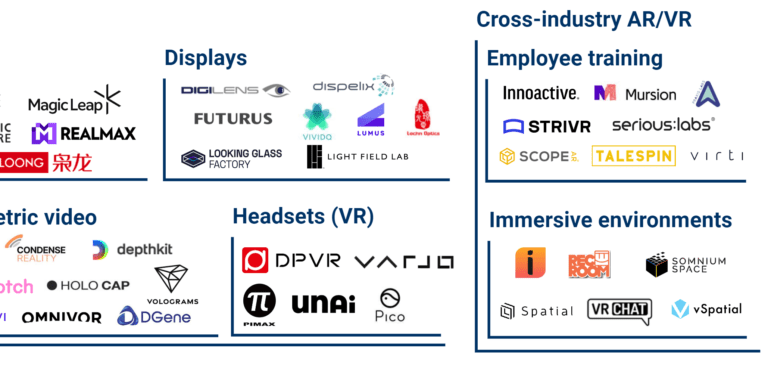
Niantic
Founded Year
2011Stage
Series D | AliveTotal Raised
$770MValuation
$0000Last Raised
$300M | 3 yrs agoRevenue
$0000Mosaic Score The Mosaic Score is an algorithm that measures the overall financial health and market potential of private companies.
-3 points in the past 30 days
About Niantic
Niantic develops augmented reality (AR) technology. The company's main offerings include AR games and applications that encourage exploration of the physical world. It primarily serves the gaming and application development sectors. The company was founded in 2011 and is based in San Francisco, California.
Loading...
ESPs containing Niantic
The ESP matrix leverages data and analyst insight to identify and rank leading companies in a given technology landscape.
The augmented reality/virtual reality (AR/VR) gaming market (also called spatial computing gaming) offers immersive gaming experiences through the use of virtual and augmented reality technologies. This market has seen significant growth in recent years due to advancements in technology and increased consumer demand for more interactive and engaging gaming experiences. AR/VR gaming solutions offer…
Niantic named as Leader among 8 other companies, including Roblox, Resolution Games, and Illumix.
Loading...
Research containing Niantic
Get data-driven expert analysis from the CB Insights Intelligence Unit.
CB Insights Intelligence Analysts have mentioned Niantic in 3 CB Insights research briefs, most recently on Nov 21, 2023.
Expert Collections containing Niantic
Expert Collections are analyst-curated lists that highlight the companies you need to know in the most important technology spaces.
Niantic is included in 4 Expert Collections, including AR/VR.
AR/VR
1,505 items
This collection includes companies creating hardware and/or software for augmented reality, virtual reality, and mixed reality applications.
Unicorns- Billion Dollar Startups
1,244 items
Gaming
5,181 items
Gaming companies are defined as those developing technologies for the PC, console, mobile, and/or AR/VR video gaming market.
Tech IPO Pipeline
825 items
Niantic Patents
Niantic has filed 113 patents.
The 3 most popular patent topics include:
- virtual reality
- mixed reality
- augmented reality

Application Date | Grant Date | Title | Related Topics | Status |
|---|---|---|---|---|
4/12/2021 | 9/17/2024 | Geosocial networking, Global Positioning System, Geolocation, Social networking services, Virtual reality | Grant |
Application Date | 4/12/2021 |
|---|---|
Grant Date | 9/17/2024 |
Title | |
Related Topics | Geosocial networking, Global Positioning System, Geolocation, Social networking services, Virtual reality |
Status | Grant |
Latest Niantic News
Sep 17, 2024
Print In its relentless search for ways to weave digital products into people’s lives, Big Tech has achieved some big wins. Smart phones are ubiquitous. Apple Watch users talk to their wrists. Artificial intelligence-powered assistants are everywhere. But convincing people to wear computers on their faces has been a dud. So far, at least. Augmented reality glasses overlay digital images onto a person’s view of the physical world. They’re different from virtual reality headsets that fully immerse people into a computer-generated environment. Tech giants have been focused in the last decade on developing eye glasses that project digital screens in front of a user’s eyes. The fact that they have so far failed to convince people to wear smart glasses daily hasn’t deterred Google and other companies from pouring money into the effort as they pursue a belief the hardware could one day reshape how people socialize, work and learn. Advertisement While dwarfed by the Silicon Valley behemoths to the north, Snap, the Los Angeles-based company behind the disappearing messaging app Snapchat is competing in this smart glasses arms race. The company, which unveiled its fifth version of AR glasses at its annual conference Tuesday, hopes improving the device will drive mass consumer adoption. “Making augmented reality glasses is really hard. And we know that the industry is littered with companies that have tried and we’ve been working for a really long time on these,” Snap’s Chief Executive Evan Spiegel said Tuesday from the stage at the conference as he unveiled the glasses. Other industry giants including Google and Samsung are also working on smart glasses, and Apple is exploring the idea. The competition raises the stakes for the publicly traded Snap as it looks to new products to help reassert itself in the tech world as rivals such as Instagram and TikTok have surged past it to capture eyeballs and market dominance. Advertisement May 20, 2024 But a future in which augmented reality glasses are a part of our daily lives hasn’t arrive yet and a long road still remains ahead, experts say. The future of smart glasses is still murky. “This is a marathon. It’s not a sprint,” said Tuong Huy Nguyen, an analyst at Gartner who is part of a team that researches immersive technologies including AR. “We need an ecosystem of not just hardware and software but content to work together to create seamless experiences.” Snap first released smart glasses that could record video in 2016, selling them in vending machines in Los Angeles before making them available online. The company reported selling 150,000 pairs, but most people stopped using them after a month and underwhelming demand for the gadget resulted in hundreds of thousands of unsold pairs. Advertisement Named Spectacles, Snap’s latest eyewear overlays computer-generated images onto a person’s view of the physical world. The new device builds on the first AR glasses Snap released to software developers in 2021. Snap isn’t selling to them to the public, but is making them available to software developers in hopes they’ll design experiances for the platform. What people can do with AR glasses remain limited. Snap’s glasses can track a person’s hands, allowing users to pick up and assemble virtual Legos, swing a phantom golf club, draw with friends and punch numbers in a digital calculator. It also incorporates some artificial intelligence features that allows users to get answers to questions and conjure an image with a voice command. In an attempt to drum up interest, Snap has been leaning into whimsical applications and gaming experiences that it knows users are used to, said Ben Bajarin, chief executive and principal analyst at Creative Strategies, a consulting firm that works with tech companies. Nov. 10, 2016 But Snap is still treading cautiously as it releases new AR glasses. “What we can’t predict is consumer adoption and so that’s why we’re taking this more thoughtful approach to how we’re releasing this version,” said Sophia Dominguez, Snap’s director of AR Platform. “It could change at any time, and if it does change … we’re ready to go.” Dominguez said the company envisions AR glasses one day becoming the primary way people access the digital world. Instead of computer or phone screens, AR glasses, she said, will allow people to keep one foot in each world simultaneously, making it “easy for you to interact with technology in the same way that you interact with the real world.” Advertisement Skepticism whether AR glasses will make this possible runs high. Donning AR glasses could interfere with how people socialize in the physical world, making them feel less present, said Jeremy Bailenson, a Stanford University professor who founded the college’s virtual human interaction lab. “Wearing glasses that connect you to digital content, whether it’s AR or VR should be done sparingly for special experiences,” he said. “I am not an advocate of blocking your perceptual system, sight and sound for constant surveillance.” Bailenson and other Stanford researchers tested out the Meta Quest 3, a “mixed reality” headset that lets people blend physical and virtual worlds. While the headset is different from AR glasses, the gadget can display real-time video of a user’s surroundings in the physical world. Researchers, who were accompanied by a chaperone for safety reasons, wore Meta’s headsets while chatting with people, walking around campus and cooking food. They reported that people in the physical world felt less real, as if they were watching television rather than interacting with someone face-to-face. People wearing AR glasses will also see a different view of the world than people not wearing the devices and losing that “common ground” will likely impact the way people socialize, Bailenson said. Previous attempts at integrating smart glasses into people’s lives have not gone well. When Google released smart glasses in 2013 that could shoot photos, videos, they sparked privacy and safety concerns from consumers, lawmakers and business owners. People started calling Google Glass owners who used the smart glasses in ways that were socially unacceptable “glassholes.” Among the social no-nos: Surreptitiously recording others and reading on the device while seeming to ignore others. Advertisement And while AR glasses have the potential to be helpful in several arenas, including training, education, shopping and gaming, industry analysts said it will be difficult convincing consumers to embrace the devices. “Our eyes are very precious real estate,” said Bajarin, who tried out Snap’s AR glasses ahead of their conference. “Consumers are going to guard that very, very heavily.” Keeping the price low enough to entice people to buy will also be a challenge. Meta, which partnered with Ray Ban on a pair of smart glasses that allows people to capture photos, listen to music and take video calls with the help of an AI assistant, sells its device for around $300. Snap has not said what it will charge for its latest glasses should they become available to the public. July 7, 2024 Snap’s glasses remain a work in progress. They’re heavier than regular glasses, heat up to an uncomfortable degree after extended use and the battery life is under an hour. They require foreign hand movements, such as reaching out to pinch digital objects in the air and tapping the front and back of one’s hand to adjust the volume or launch a menu. The device is powered by Snap’s own operating system, giving the company more control over the experience. During a recent preview of the AR glasses held in a San Francisco home, a Times reporter used voice commands to create images that appeared almost instantly — a robot dog, Elsa from Frozen and the San Francisco skyline. In another activity, a wide-eyed, yellow creature appeared before making its way outside to a real San Francisco patio with a stunning view of the city. Niantic, the maker of AR game Pokemon Go, created the experience “Peridot Beyond” for Snap’s AR glasses. Advertisement Asim Ahmed, who leads global marketing at Niantic, said AR glasses gives the company the opportunity to experiment and design a “new kind of paradigm of gameplay.” What works in a game played on a mobile phone might not work on AR glasses, which offer a wider field of view and don’t rely so heavily on hands to play. Niantic also had to think about safety issues, including making sure the virtual pet doesn’t get too close to their owner and blocks their view. With an array of challenges, including figuring out how to jam processing power and other computing hardware into a device that is smaller than a smartphone, analysts predict it will take several years at least before smart glasses gain mainstream adoption, if they ever do. In the first quarter of 2024, shipments of VR and AR headsets dropped 67.4% year-over-year but are expected to improve as consumers transition to new types of devices, according to market intelligence firm IDC . Meta led the market, followed by ByteDance, Xreal and HTC. With companies still testing out AR glasses or developing them, a clear front-runner hasn’t emerged yet, analysts said. Jacob Bourne, an analyst at eMarketer, said Snap’s rivals, including Meta and Google, have more money to invest in research and development of AR glasses. Meta, which owns Facebook, Instagram and WhatsApp, has 3.27 billion people using one of their apps every day. Snapchat has 432 million daily active users. “I would probably put my money more on Meta as having the key to the [research and development] capabilities to really get that to market,” Bourne said. “But I wouldn’t rule Snap out at all.” More to Read
Niantic Frequently Asked Questions (FAQ)
When was Niantic founded?
Niantic was founded in 2011.
Where is Niantic's headquarters?
Niantic's headquarters is located at 1 Ferry Building, San Francisco.
What is Niantic's latest funding round?
Niantic's latest funding round is Series D.
How much did Niantic raise?
Niantic raised a total of $770M.
Who are the investors of Niantic?
Investors of Niantic include Institutional Venture Partners, Coatue, Google, Founders Fund, Spark Capital and 20 more.
Who are Niantic's competitors?
Competitors of Niantic include Infinite Reality and 8 more.
Loading...
Compare Niantic to Competitors
CRYENGINE is a company that focuses on game development, operating within the technology and gaming industry. The company provides a comprehensive platform for creating immersive gaming experiences, offering features such as real-time dynamic global illumination, physical simulations, audio translation layer, and a fully-featured editor for creating and testing game environments. The company primarily serves the gaming industry. It is based in Hessen, Germany.

Zappar is a company that focuses on augmented reality (AR) and mixed reality (MR), operating within the technology and creative industries. The company offers a range of services including AR campaign planning, strategy, and execution, as well as providing tools for creating AR experiences. They also offer a mixed reality headset powered by a smartphone, and accessible QR codes for product packaging. Zappar primarily sells to sectors such as retail, marketing, events, tours and attractions, and learning and development. It is based in London, England.
Meta specializes in online psychological and psychotherapeutic services. The company offers a platform for individuals to find and connect with verified psychologists and psychotherapists for personal or online sessions. The service caters to a wide range of mental health issues and provides individual, couple, and child therapy options. It is based in Moscow, Russian Federation.
Aurasma is a product of HP Autonomy. Aurasma is an augmented reality platform and is available as a software development kit or as a free app for iOS- and Android-based mobile devices.
Snap is a company that specializes in providing a comprehensive online lottery gaming experience within the gambling industry. Its main offerings include a variety of lottery games where users can bet on the outcomes of different lottery draws, including 2D, 3D, and 4D bets, as well as a range of other predictive betting games based on lottery results. It was founded in 2016 and is based in London, England.
DeepAR is a technology company that specializes in augmented reality (AR) within the software industry. The company provides a software development kit (SDK) that allows developers to integrate AR features such as face filters, background replacement, emotion detection, and body tracking into their applications or websites. These services are primarily used in the ecommerce and advertising industries, enabling virtual product try-ons and interactive AR advertising. It was founded in 2014 and is based in London, England.
Loading...


